tidy3d.Simulation#
- class Simulation[source]#
Bases:
AbstractYeeGridSimulationCustom implementation of Maxwell’s equations which represents the physical model to be solved using the FDTD method.
- Parameters:
attrs (dict = {}) – Dictionary storing arbitrary metadata for a Tidy3D object. This dictionary can be freely used by the user for storing data without affecting the operation of Tidy3D as it is not used internally. Note that, unlike regular Tidy3D fields,
attrsare mutable. For example, the following is allowed for setting anattrobj.attrs['foo'] = bar. Also note that Tidy3D` will raise aTypeErrorifattrscontain objects that can not be serialized. One can check ifattrsare serializable by callingobj.json().center (Union[tuple[Union[float, autograd.tracer.Box], Union[float, autograd.tracer.Box], Union[float, autograd.tracer.Box]], Box] = (0.0, 0.0, 0.0)) – [units = um]. Center of object in x, y, and z.
size (Union[tuple[Union[pydantic.v1.types.NonNegativeFloat, autograd.tracer.Box], Union[pydantic.v1.types.NonNegativeFloat, autograd.tracer.Box], Union[pydantic.v1.types.NonNegativeFloat, autograd.tracer.Box]], Box]) – [units = um]. Size in x, y, and z directions.
medium (Union[Medium, AnisotropicMedium, PECMedium, PoleResidue, Sellmeier, Lorentz, Debye, Drude, FullyAnisotropicMedium, CustomMedium, CustomPoleResidue, CustomSellmeier, CustomLorentz, CustomDebye, CustomDrude, CustomAnisotropicMedium, PerturbationMedium, PerturbationPoleResidue] = Medium(attrs={}, name=None, frequency_range=None, allow_gain=False, nonlinear_spec=None, modulation_spec=None, heat_spec=None, type='Medium', permittivity=1.0, conductivity=0.0)) – Background medium of simulation, defaults to vacuum if not specified.
structures (Tuple[Structure, ...] = ()) – Tuple of structures present in simulation. Note: Structures defined later in this list override the simulation material properties in regions of spatial overlap.
symmetry (Tuple[Literal[0, -1, 1], Literal[0, -1, 1], Literal[0, -1, 1]] = (0, 0, 0)) – Tuple of integers defining reflection symmetry across a plane bisecting the simulation domain normal to the x-, y-, and z-axis at the simulation center of each axis, respectively. Each element can be
0(no symmetry),1(even, i.e. ‘PMC’ symmetry) or-1(odd, i.e. ‘PEC’ symmetry). Note that the vectorial nature of the fields must be taken into account to correctly determine the symmetry value.sources (Tuple[Annotated[Union[tidy3d.components.source.UniformCurrentSource, tidy3d.components.source.PointDipole, tidy3d.components.source.GaussianBeam, tidy3d.components.source.AstigmaticGaussianBeam, tidy3d.components.source.ModeSource, tidy3d.components.source.PlaneWave, tidy3d.components.source.CustomFieldSource, tidy3d.components.source.CustomCurrentSource, tidy3d.components.source.TFSF], FieldInfo(default=PydanticUndefined, discriminator='type', extra={})], ...] = ()) – Tuple of electric current sources injecting fields into the simulation.
boundary_spec (BoundarySpec = BoundarySpec(attrs={}, x=Boundary(attrs={},, plus=PML(attrs={},, name=None,, type='PML',, num_layers=12,, parameters=PMLParams(attrs={},, sigma_order=3,, sigma_min=0.0,, sigma_max=1.5,, type='PMLParams',, kappa_order=3,, kappa_min=1.0,, kappa_max=3.0,, alpha_order=1,, alpha_min=0.0,, alpha_max=0.0)),, minus=PML(attrs={},, name=None,, type='PML',, num_layers=12,, parameters=PMLParams(attrs={},, sigma_order=3,, sigma_min=0.0,, sigma_max=1.5,, type='PMLParams',, kappa_order=3,, kappa_min=1.0,, kappa_max=3.0,, alpha_order=1,, alpha_min=0.0,, alpha_max=0.0)),, type='Boundary'), y=Boundary(attrs={},, plus=PML(attrs={},, name=None,, type='PML',, num_layers=12,, parameters=PMLParams(attrs={},, sigma_order=3,, sigma_min=0.0,, sigma_max=1.5,, type='PMLParams',, kappa_order=3,, kappa_min=1.0,, kappa_max=3.0,, alpha_order=1,, alpha_min=0.0,, alpha_max=0.0)),, minus=PML(attrs={},, name=None,, type='PML',, num_layers=12,, parameters=PMLParams(attrs={},, sigma_order=3,, sigma_min=0.0,, sigma_max=1.5,, type='PMLParams',, kappa_order=3,, kappa_min=1.0,, kappa_max=3.0,, alpha_order=1,, alpha_min=0.0,, alpha_max=0.0)),, type='Boundary'), z=Boundary(attrs={},, plus=PML(attrs={},, name=None,, type='PML',, num_layers=12,, parameters=PMLParams(attrs={},, sigma_order=3,, sigma_min=0.0,, sigma_max=1.5,, type='PMLParams',, kappa_order=3,, kappa_min=1.0,, kappa_max=3.0,, alpha_order=1,, alpha_min=0.0,, alpha_max=0.0)),, minus=PML(attrs={},, name=None,, type='PML',, num_layers=12,, parameters=PMLParams(attrs={},, sigma_order=3,, sigma_min=0.0,, sigma_max=1.5,, type='PMLParams',, kappa_order=3,, kappa_min=1.0,, kappa_max=3.0,, alpha_order=1,, alpha_min=0.0,, alpha_max=0.0)),, type='Boundary'), type='BoundarySpec')) – Specification of boundary conditions along each dimension. If
None, PML boundary conditions are applied on all sides.monitors (Tuple[Annotated[Union[tidy3d.components.monitor.FieldMonitor, tidy3d.components.monitor.FieldTimeMonitor, tidy3d.components.monitor.PermittivityMonitor, tidy3d.components.monitor.FluxMonitor, tidy3d.components.monitor.FluxTimeMonitor, tidy3d.components.monitor.ModeMonitor, tidy3d.components.monitor.ModeSolverMonitor, tidy3d.components.monitor.FieldProjectionAngleMonitor, tidy3d.components.monitor.FieldProjectionCartesianMonitor, tidy3d.components.monitor.FieldProjectionKSpaceMonitor, tidy3d.components.monitor.DiffractionMonitor], FieldInfo(default=PydanticUndefined, discriminator='type', extra={})], ...] = ()) – Tuple of monitors in the simulation. Note: monitor names are used to access data after simulation is run.
grid_spec (GridSpec = GridSpec(attrs={}, grid_x=AutoGrid(attrs={},, type='AutoGrid',, min_steps_per_wvl=10.0,, max_scale=1.4,, dl_min=0.0,, mesher=GradedMesher(attrs={},, type='GradedMesher')), grid_y=AutoGrid(attrs={},, type='AutoGrid',, min_steps_per_wvl=10.0,, max_scale=1.4,, dl_min=0.0,, mesher=GradedMesher(attrs={},, type='GradedMesher')), grid_z=AutoGrid(attrs={},, type='AutoGrid',, min_steps_per_wvl=10.0,, max_scale=1.4,, dl_min=0.0,, mesher=GradedMesher(attrs={},, type='GradedMesher')), wavelength=None, override_structures=(), snapping_points=(), type='GridSpec')) – Specifications for the simulation grid along each of the three directions.
version (str = 2.7.3) – String specifying the front end version number.
lumped_elements (Tuple[Union[LumpedResistor, CoaxialLumpedResistor], ...] = ()) – Tuple of lumped elements in the simulation. Note: only
tidy3d.LumpedResistoris supported currently.subpixel (Union[bool, SubpixelSpec] = SubpixelSpec(attrs={}, dielectric=PolarizedAveraging(attrs={},, type='PolarizedAveraging'), metal=Staircasing(attrs={},, type='Staircasing'), pec=PECConformal(attrs={},, type='PECConformal',, timestep_reduction=0.3), type='SubpixelSpec')) – Apply subpixel averaging methods of the permittivity on structure interfaces to result in much higher accuracy for a given grid size. Supply a
SubpixelSpecto this field to select subpixel averaging methods separately on dielectric, metal, and PEC material interfaces. Alternatively, user may supply a boolean value:Trueto apply the default subpixel averaging methods corresponding toSubpixelSpec(), orFalseto apply staircasing.simulation_type (Optional[Literal['autograd_fwd', 'autograd_bwd', None]] = None) – Tag used internally to distinguish types of simulations for
autogradgradient processing.courant (ConstrainedFloatValue = 0.99) – Normalized Courant stability factor that is no larger than 1 when CFL stability condition is met. It controls time step to spatial step ratio. Lower values lead to more stable simulations for dispersive materials, but result in longer simulation times.
normalize_index (Optional[NonNegativeInt] = 0) – Index of the source in the tuple of sources whose spectrum will be used to normalize the frequency-dependent data. If
None, the raw field data is returned unnormalized.shutoff (NonNegativeFloat = 1e-05) – Ratio of the instantaneous integrated E-field intensity to the maximum value at which the simulation will automatically terminate time stepping. Used to prevent extraneous run time of simulations with fully decayed fields. Set to
0to disable this feature.run_time (Union[PositiveFloat, RunTimeSpec]) – [units = sec]. Total electromagnetic evolution time in seconds. Note: If simulation ‘shutoff’ is specified, simulation will terminate early when shutoff condition met. Alternatively, user may supply a
RunTimeSpecto this field, which will auto-compute therun_timebased on the contents of the spec. If this option is used, the evaluatedrun_timevalue is available in theSimulation._run_timeproperty.
Notes
A
Simulationdefines a custom implementation of Maxwell’s equations which represents the physical model to be solved using the Finite-Difference Time-Domain (FDTD) method.tidy3dsimulations run very quickly in the cloud through GPU parallelization.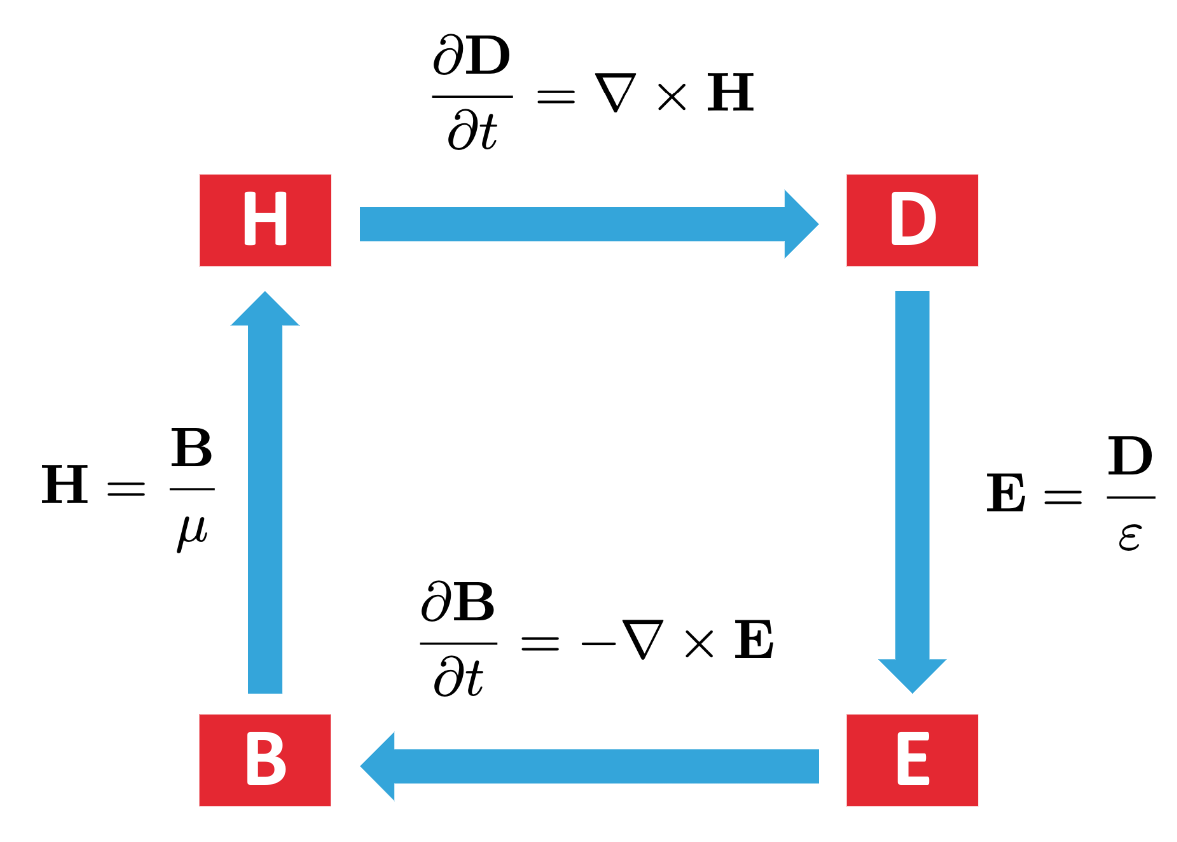
FDTD is a method for simulating the interaction of electromagnetic waves with structures and materials. It is the most widely used method in photonics design. The Maxwell’s equations implemented in the
Simulationare solved per time-step in the order shown in this image.The simplified input to FDTD solver consists of the permittivity distribution defined by
structureswhich describe the device andsourcesof electromagnetic excitation. This information is used to computate the time dynamics of the electric and magnetic fields in this system. From these time-domain results, frequency-domain information of the simulation can also be extracted, and used for device design and optimization.If you are new to the FDTD method, we recommend you get started with the FDTD 101 Lecture Series
Dimensions Selection
By default, simulations are defined as 3D. To make the simulation 2D, we can just set the simulation
sizein one of the dimensions to be 0. However, note that we still have to define a grid size (eg.tidy3d.Simulation(size=[size_x, size_y, 0])) and specify a periodic boundary condition in that direction.See further parameter explanations below.
Example
>>> from tidy3d import Sphere, Cylinder, PolySlab >>> from tidy3d import UniformCurrentSource, GaussianPulse >>> from tidy3d import FieldMonitor, FluxMonitor >>> from tidy3d import GridSpec, AutoGrid >>> from tidy3d import BoundarySpec, Boundary >>> from tidy3d import Medium >>> sim = Simulation( ... size=(3.0, 3.0, 3.0), ... grid_spec=GridSpec( ... grid_x = AutoGrid(min_steps_per_wvl = 20), ... grid_y = AutoGrid(min_steps_per_wvl = 20), ... grid_z = AutoGrid(min_steps_per_wvl = 20) ... ), ... run_time=40e-11, ... structures=[ ... Structure( ... geometry=Box(size=(1, 1, 1), center=(0, 0, 0)), ... medium=Medium(permittivity=2.0), ... ), ... ], ... sources=[ ... UniformCurrentSource( ... size=(0, 0, 0), ... center=(0, 0.5, 0), ... polarization="Hx", ... source_time=GaussianPulse( ... freq0=2e14, ... fwidth=4e13, ... ), ... ) ... ], ... monitors=[ ... FluxMonitor(size=(1, 1, 0), center=(0, 0, 0), freqs=[2e14, 2.5e14], name='flux'), ... ], ... symmetry=(0, 0, 0), ... boundary_spec=BoundarySpec( ... x = Boundary.pml(num_layers=20), ... y = Boundary.pml(num_layers=30), ... z = Boundary.periodic(), ... ), ... shutoff=1e-6, ... courant=0.8, ... subpixel=False, ... )
See also
- Notebooks:
Quickstart: Usage in a basic simulation flow.
See nearly all notebooks for
Simulationapplications.
- Lectures:
Introduction to FDTD Simulation: Usage in a basic simulation flow.
- GUI:
Attributes
List of all structures in the simulation (including the
Simulation.medium).Trueif any of the mediums in the simulation allows gain.Returns structure representing the background of the
Simulation.Whether complex fields are used in the simulation.
List of custom datasets for verification purposes.
Simulation time step (distance).
Unique list of all frequencies.
Range of frequencies spanning all sources' frequency dependence.
FDTD grid spatial locations and information.
Returns dict mapping medium to index in material.
Returns set of distinct
AbstractMediumin simulation.Dictionary mapping monitor names to their estimated storage size in bytes.
Maximum refractive index in the
Simulation.Number of cells in the simulation grid.
Number of cells in the computational domain for this simulation.
Number of time steps in simulation.
Maximum number of discrete time steps to keep sampling below Nyquist limit.
When conformal mesh is applied, courant number is scaled down depending on conformal_mesh_spec.
The simulation background as a
Structure.Structures in simulation with all autograd tracers removed.
FDTD time stepping points.
Minimum wavelength in the materials present throughout the simulation.
versionDO NOT EDIT: Modified automatically with .bump2version.cfg
Methods
bloch_boundaries_diff_mnt(val, values)Error if there are diffraction monitors incompatible with boundary conditions.
bloch_with_symmetry(val, values)Error if a Bloch boundary is applied with symmetry
boundaries_for_zero_dims(val, values)Error if absorbing boundaries, bloch boundaries, unmatching pec/pmc, or symmetry is used along a zero dimension.
diffraction_monitor_boundaries(val, values)If any
DiffractionMonitorexists, ensure boundary conditions in the transverse directions are periodic or Bloch.diffraction_monitor_medium(val, values)If any
DiffractionMonitorexists, ensure is does not lie in a lossy medium.from_scene(scene, **kwargs)Create a simulation from a
Sceneinstance.get_refractive_indices(freq)List of refractive indices in the simulation at a given frequency.
intersecting_media(test_object, structures)From a given list of structures, returns a list of
AbstractMediumassociated with those structures that intersect with thetest_object, if it is a surface, or its surfaces, if it is a volume.intersecting_structures(test_object, structures)From a given list of structures, returns a list of
Structurethat intersect with thetest_object, if it is a surface, or its surfaces, if it is a volume.make_adjoint_monitors(structure_indices)Get lists of field and permittivity monitors for this simulation.
monitor_medium(monitor)Return the medium in which the given monitor resides.
perturbed_mediums_copy([temperature, ...])Return a copy of the simulation with heat and/or charge data applied to all mediums that have perturbation models specified.
plane_wave_boundaries(val, values)Error if there are plane wave sources incompatible with boundary conditions.
plot_3d([width, height])Render 3D plot of
Simulation(in jupyter notebook only).proj_distance_for_approx(val, values)Warn if projection distance for projection monitors is not large compared to monitor or, simulation size, yet far_field_approx is True.
tfsf_boundaries(val, values)Error if the boundary conditions are compatible with TFSF sources, if any.
tfsf_with_symmetry(val, values)Error if a TFSF source is applied with symmetry
to_gds(cell[, x, y, z, ...])Append the simulation structures to a .gds cell.
to_gds_file(fname[, x, y, z, ...])Append the simulation structures to a .gds cell.
to_gdspy([x, y, z, gds_layer_dtype_map])Convert a simulation's planar slice to a .gds type polygon list.
to_gdstk([x, y, z, permittivity_threshold, ...])Convert a simulation's planar slice to a .gds type polygon list.
validate_pre_upload([source_required])Validate the fully initialized simulation is ok for upload to our servers.
with_adjoint_monitors(sim_fields_keys)Copy of self with adjoint field and permittivity monitors for every traced structure.
Inherited Common Usage
- boundary_spec#
Specification of boundary conditions along each dimension. If
None,PMLboundary conditions are applied on all sides.Example
Simple application reference:
Simulation( ... boundary_spec=BoundarySpec( x = Boundary.pml(num_layers=20), y = Boundary.pml(num_layers=30), z = Boundary.periodic(), ), ... )
See also
PML:A perfectly matched layer model.
BoundarySpec:Specifies boundary conditions on each side of the domain and along each dimension.
- Index
All boundary condition models.
- Notebooks
- Lectures
- courant#
The Courant-Friedrichs-Lewy (CFL) stability factor \(C\), controls time step to spatial step ratio. A physical wave has to propagate slower than the numerical information propagation in a Yee-cell grid. This is because in this spatially-discrete grid, information propagates over 1 spatial step \(\Delta x\) over a time step \(\Delta t\). This constraint enables the correct physics to be captured by the simulation.
1D Illustration
In a 1D model:
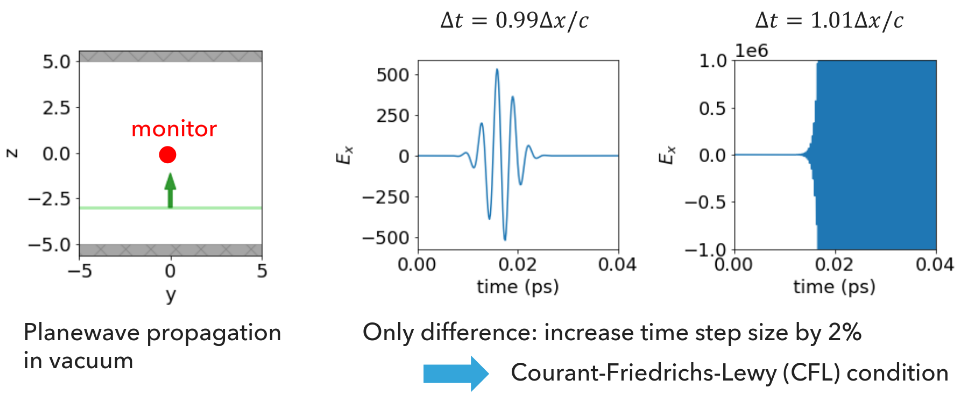
Lower values lead to more stable simulations for dispersive materials, but result in longer simulation times. This factor is normalized to no larger than 1 when CFL stability condition is met in 3D.
For a 1D grid:
\[C_{\text{1D}} = \frac{c \Delta t}{\Delta x} \leq 1\]2D Illustration
In a 2D uniform grid, where the \(E_z\) field is at the red dot center surrounded by four green magnetic edge components in a square Yee cell grid:
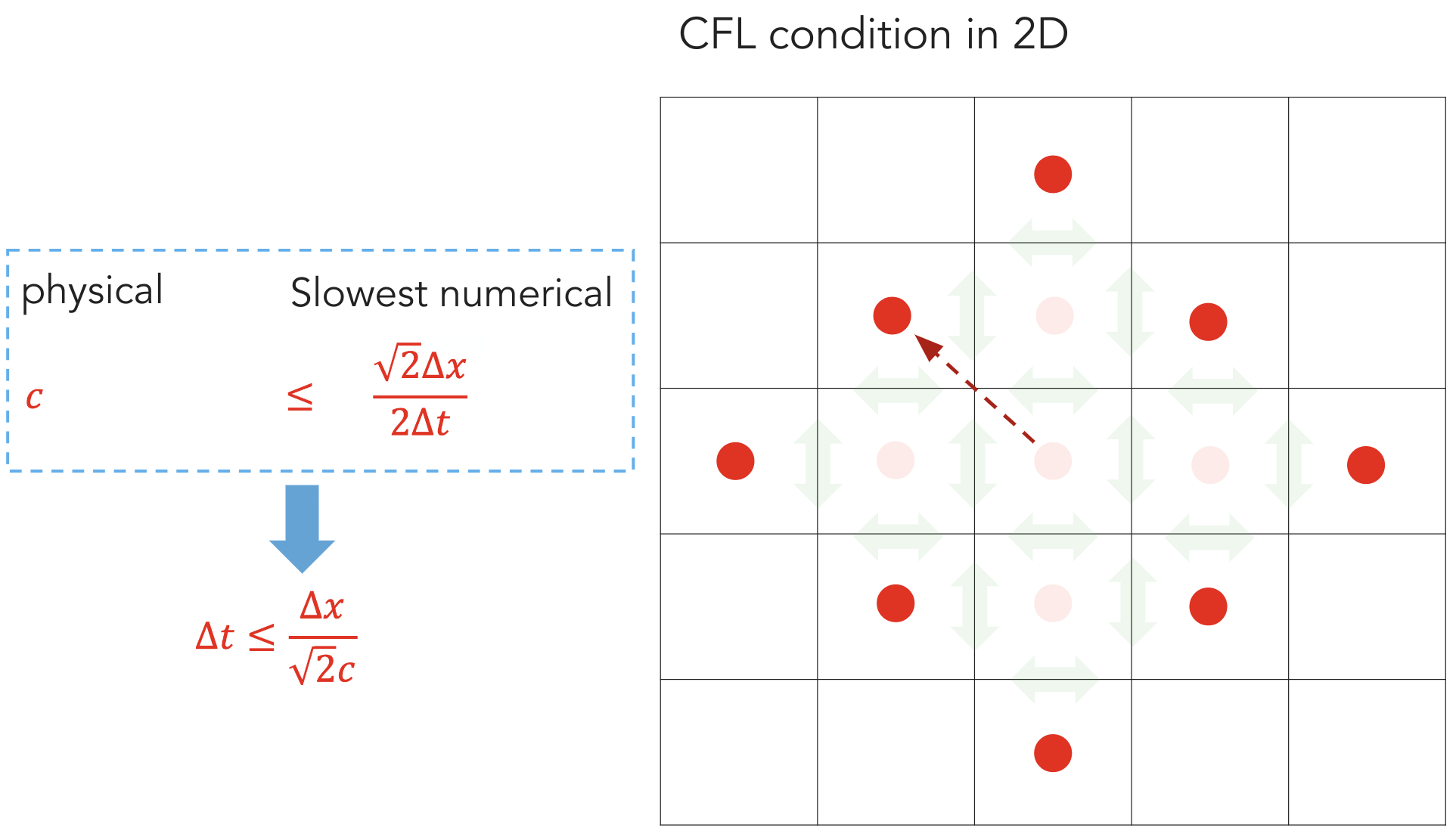 \[C_{\text{2D}} = \frac{c\Delta t}{\Delta x} \leq \frac{1}{\sqrt{2}}\]
\[C_{\text{2D}} = \frac{c\Delta t}{\Delta x} \leq \frac{1}{\sqrt{2}}\]Hence, for the same spatial grid, the time step in 2D grid needs to be smaller than the time step in a 1D grid. Note we use a normalized Courant number in our simulation, which in 2D is \(\sqrt{2}C_{\text{2D}}\). CFL stability condition is met when the normalized Courant number is no larger than 1.
3D Illustration
For an isotropic medium with refractive index \(n\), the 3D time step condition can be derived to be:
\[\Delta t \le \frac{n}{c \sqrt{\frac{1}{\Delta x^2} + \frac{1}{\Delta y^2} + \frac{1}{\Delta z^2}}}\]In this case, the number of spatial grid points scale by \(\sim \frac{1}{\Delta x^3}\) where \(\Delta x\) is the spatial discretization in the \(x\) dimension. If the total simulation time is kept the same whilst maintaining the CFL condition, then the number of time steps required scale by \(\sim \frac{1}{\Delta x}\). Hence, the spatial grid discretization influences the total time-steps required. The total simulation scaling per spatial grid size in this case is by \(\sim \frac{1}{\Delta x^4}.\)
As an example, in this case, refining the mesh by a factor or 2 (reducing the spatial step size by half) \(\Delta x \to \frac{\Delta x}{2}\) will increase the total simulation computational cost by 16.
Divergence Caveats
tidy3duses a default Courant factor of 0.99. When a dispersive material witheps_inf < 1is used, the Courant factor will be automatically adjusted to be smaller thansqrt(eps_inf)to ensure stability. If your simulation still diverges despite addressing any other issues discussed above, reducing the Courant factor may help.See also
grid_specSpecifications for the simulation grid along each of the three directions.
- Lectures:
- lumped_elements#
Tuple of lumped elements in the simulation.
Example
Simple application reference:
Simulation( ... lumped_elements=[ LumpedResistor( size=(0, 3, 1), center=(0, 0, 0), voltage_axis=2, resistance=50, name="resistor_1", ) ], ... )
See also
- Index:
Available lumped element types.
- grid_spec#
Specifications for the simulation grid along each of the three directions.
Example
Simple application reference:
Simulation( ... grid_spec=GridSpec( grid_x = AutoGrid(min_steps_per_wvl = 20), grid_y = AutoGrid(min_steps_per_wvl = 20), grid_z = AutoGrid(min_steps_per_wvl = 20) ), ... )
Usage Recommendations
In the finite-difference time domain method, the computational domain is discretized by a little cubes called the Yee cell. A discrete lattice formed by this Yee cell is used to describe the fields. In 3D, the electric fields are distributed on the edge of the Yee cell and the magnetic fields are distributed on the surface of the Yee cell.
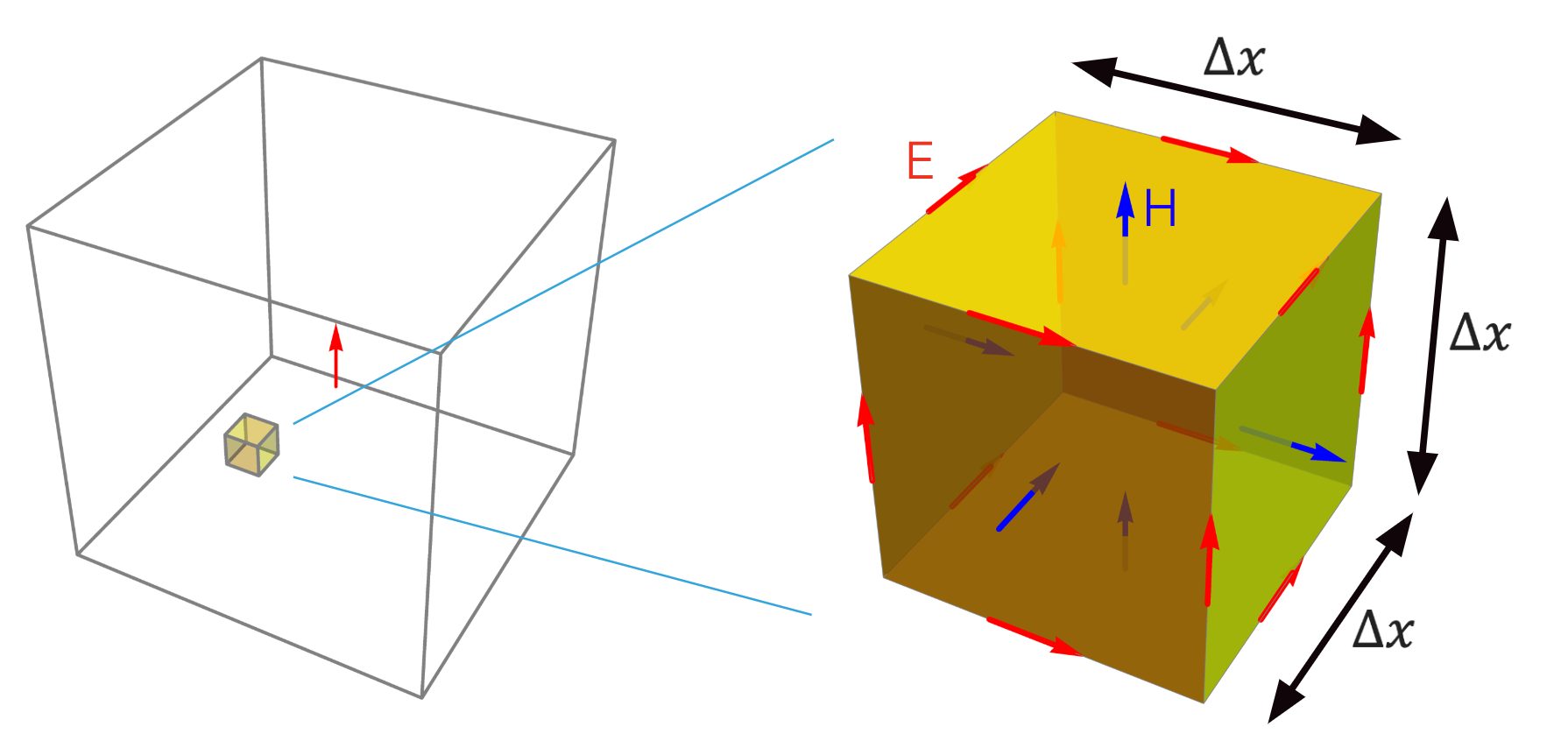
Note
A typical rule of thumb is to choose the discretization to be about \(\frac{\lambda_m}{20}\) where \(\lambda_m\) is the field wavelength.
Numerical Dispersion - 1D Illustration
Numerical dispersion is a form of numerical error dependent on the spatial and temporal discretization of the fields. In order to reduce it, it is necessary to improve the discretization of the simulation for particular frequencies and spatial features. This is an important aspect of defining the grid.
Consider a standard 1D wave equation in vacuum:
\[\left( \frac{\delta ^2 }{\delta x^2} - \frac{1}{c^2} \frac{\delta^2}{\delta t^2} \right) E = 0\]which is ideally solved into a monochromatic travelling wave:
\[E(x) = e^{j (kx - \omega t)}\]This physical wave is described with a wavevector \(k\) for the spatial field variations and the angular frequency \(\omega\) for temporal field variations. The spatial and temporal field variations are related by a dispersion relation.
The ideal dispersion relation is:
\[\left( \frac{\omega}{c} \right)^2 = k^2\]However, in the FDTD simulation, the spatial and temporal fields are discrete.

The same 1D monochromatic wave can be solved using the FDTD method where \(m\) is the index in the grid:
\[\frac{\delta^2}{\delta x^2} E(x_i) \approx \frac{1}{\Delta x^2} \left[ E(x_i + \Delta x) + E(x_i - \Delta x) - 2 E(x_i) \right]\]\[\frac{\delta^2}{\delta t^2} E(t_{\alpha}) \approx \frac{1}{\Delta t^2} \left[ E(t_{\alpha} + \Delta t) + E(t_{\alpha} - \Delta t) - 2 E(t_{\alpha}) \right]\]Hence, these discrete fields have this new dispersion relation:
\[\left( \frac{1}{c \Delta t} \text{sin} \left( \frac{\omega \Delta t}{2} \right)^2 \right) = \left( \frac{1}{\Delta x} \text{sin} \left( \frac{k \Delta x}{2} \right) \right)^2\]The ideal wave solution and the discrete solution have a mismatch illustrated below as a result of the numerical error introduced by numerical dispersion. This plot illustrates the angular frequency as a function of wavevector for both the physical ideal wave and the numerical discrete wave implemented in FDTD.
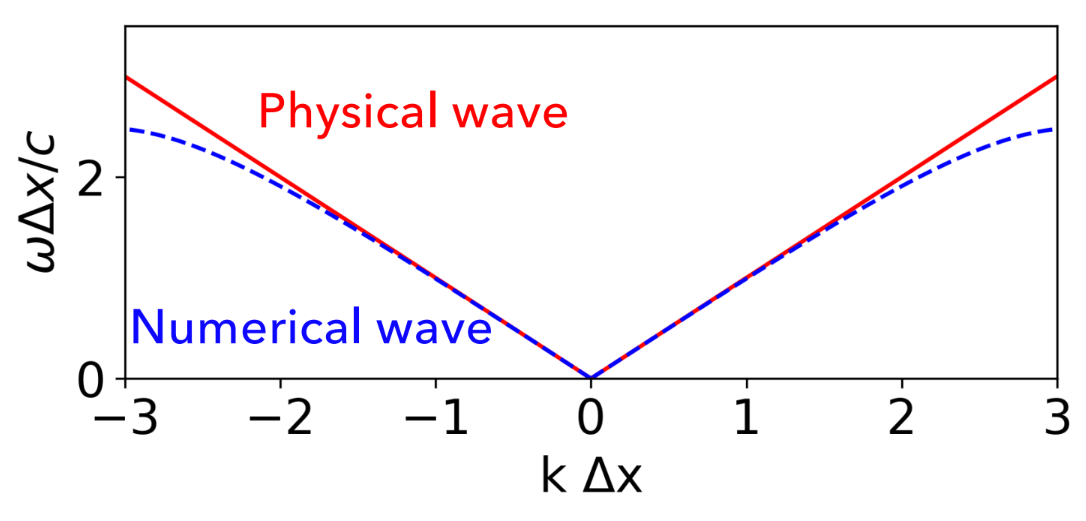
At lower frequencies, when the discretization of \(\Delta x\) is small compared to the wavelength the error between the solutions is very low. When this proportionality increases between the spatial step size and the angular wavelength, this introduces numerical dispersion errors.
\[k \Delta x = \frac{2 \pi}{\lambda_k} \Delta x\]Usage Recommendations
It is important to understand the relationship between the time-step \(\Delta t\) defined by the
courantfactor, and the spatial grid distribution to guarantee simulation stability.If your structure has small features, consider using a spatially nonuniform grid. This guarantees finer spatial resolution near the features, but away from it you use have a larger (and computationally faster) grid. In this case, the time step \(\Delta t\) is defined by the smallest spatial grid size.
See also
courantThe Courant-Friedrichs-Lewy (CFL) stability factor
GridSpecCollective grid specification for all three dimensions.
UniformGridUniform 1D grid.
AutoGridSpecification for non-uniform grid along a given dimension.
- Notebooks:
- Lectures:
- medium#
Background medium of simulation, defaults to vacuum if not specified.
See also
- Material Library:
The material library is a dictionary containing various dispersive models from real world materials.
- Index:
Dispersive and dispersionless Mediums models.
Notebooks:
Lectures:
GUI:
- normalize_index#
Index of the source in the tuple of sources whose spectrum will be used to normalize the frequency-dependent data. If
None, the raw field data is returned. IfNone, the raw field data is returned unnormalized.
- monitors#
Tuple of monitors in the simulation. Monitor names are used to access data after simulation is run.
See also
- Index
All the monitor implementations.
- sources#
Tuple of electric current sources injecting fields into the simulation.
Example
Simple application reference:
Simulation( ... sources=[ UniformCurrentSource( size=(0, 0, 0), center=(0, 0.5, 0), polarization="Hx", source_time=GaussianPulse( freq0=2e14, fwidth=4e13, ), ) ], ... )
See also
- Index:
Frequency and time domain source models.
- shutoff#
Ratio of the instantaneous integrated E-field intensity to the maximum value at which the simulation will automatically terminate time stepping. Used to prevent extraneous run time of simulations with fully decayed fields. Set to
0to disable this feature.
- structures#
Tuple of structures present in simulation. Structures defined later in this list override the simulation material properties in regions of spatial overlap.
Example
Simple application reference:
Simulation( ... structures=[ Structure( geometry=Box(size=(1, 1, 1), center=(0, 0, 0)), medium=Medium(permittivity=2.0), ), ], ... )
Usage Caveats
It is very important to understand the way the dielectric permittivity of the
Structurelist is resolved by the simulation grid. Withoutsubpixelaveraging, the structure geometry in relation to the grid points can lead to its features permittivity not being fully resolved by the simulation.For example, in the image below, two silicon slabs with thicknesses 150nm and 175nm centered in a grid with spatial discretization \(\Delta z = 25\text{nm}\) will compute equivalently because that grid does not resolve the feature permittivity in between grid points without
subpixelaveraging.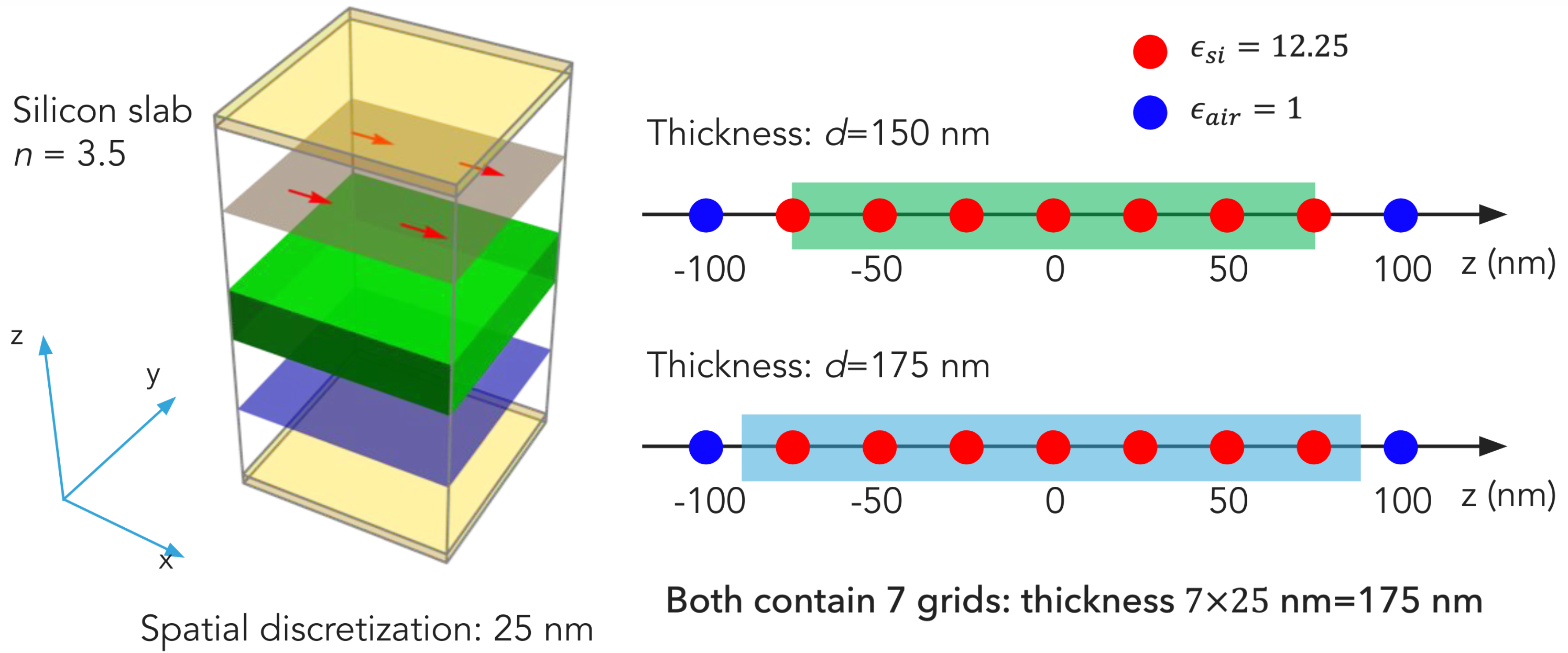
See also
Structure:Defines a physical object that interacts with the electromagnetic fields.
subpixelSubpixel averaging of the permittivity based on structure definition, resulting in much higher accuracy for a given grid size.
Notebooks:
Lectures:
GUI:
- symmetry#
You should set the
symmetryparameter in yourSimulationobject using a tuple of integers defining reflection symmetry across a plane bisecting the simulation domain normal to the x-, y-, and z-axis. Each element can be 0 (no symmetry), 1 (even, i.e.PMCsymmetry) or -1 (odd, i.e.PECsymmetry). Note that the vectorial nature of the fields must be considered to determine the symmetry value correctly.The figure below illustrates how the electric and magnetic field components transform under
PEC- andPMC-like symmetry planes. You can refer to this figure when considering whether a source field conforms to aPEC- orPMC-like symmetry axis. This would be helpful, especially when dealing with optical waveguide modes.
- run_time#
Total electromagnetic evolution time in seconds. If simulation ‘shutoff’ is specified, simulation will terminate early when shutoff condition met.
How long to run a simulation?
The frequency-domain response obtained in the FDTD simulation only accurately represents the continuous-wave response of the system if the fields at the beginning and at the end of the time stepping are (very close to) zero. So, you should run the simulation for a time enough to allow the electromagnetic fields decay to negligible values within the simulation domain.
When dealing with light propagation in a NON-RESONANT device, like a simple optical waveguide, a good initial guess to simulation run_time would be the a few times the largest domain dimension (\(L\)) multiplied by the waveguide mode group index (\(n_g\)), divided by the speed of light in a vacuum (\(c_0\)), plus the
source_time:\[t_{sim} \approx \frac{n_g L}{c_0} + t_{source}\]By default,
tidy3dchecks periodically the total field intensity left in the simulation, and compares that to the maximum total field intensity recorded at previous times. If it is found that the ratio of these two values is smaller than the defaultshutoffvalue \(10^{-5}\), the simulation is terminated as the fields remaining in the simulation are deemed negligible. The shutoff value can be controlled using theshutoffparameter, or completely turned off by setting it to zero. In most cases, the default behavior ensures that results are correct, while avoiding unnecessarily long run times. The Flex Unit cost of the simulation is also proportionally scaled down when early termination is encountered.Resonant Caveats
Should I make sure that fields have fully decayed by the end of the simulation?
The main use case in which you may want to ignore the field decay warning is when you have high-Q modes in your simulation that would require an extremely long run time to decay. In that case, you can use the the
tidy3d.plugins.resonance.ResonanceFinderplugin to analyze the modes, as well as field monitors with vaporization to capture the modal profiles. The only thing to note is that the normalization of these modal profiles would be arbitrary, and would depend on the exact run time and apodization definition. An example of such a use case is presented in our case study.
- classmethod bloch_with_symmetry(val, values)[source]#
Error if a Bloch boundary is applied with symmetry
- classmethod plane_wave_boundaries(val, values)[source]#
Error if there are plane wave sources incompatible with boundary conditions.
- classmethod bloch_boundaries_diff_mnt(val, values)[source]#
Error if there are diffraction monitors incompatible with boundary conditions.
- classmethod tfsf_boundaries(val, values)[source]#
Error if the boundary conditions are compatible with TFSF sources, if any.
- classmethod tfsf_with_symmetry(val, values)[source]#
Error if a TFSF source is applied with symmetry
- classmethod boundaries_for_zero_dims(val, values)[source]#
Error if absorbing boundaries, bloch boundaries, unmatching pec/pmc, or symmetry is used along a zero dimension.
- classmethod diffraction_monitor_boundaries(val, values)[source]#
If any
DiffractionMonitorexists, ensure boundary conditions in the transverse directions are periodic or Bloch.
- classmethod proj_distance_for_approx(val, values)[source]#
Warn if projection distance for projection monitors is not large compared to monitor or, simulation size, yet far_field_approx is True.
- classmethod diffraction_monitor_medium(val, values)[source]#
If any
DiffractionMonitorexists, ensure is does not lie in a lossy medium.
- validate_pre_upload(source_required=True)[source]#
Validate the fully initialized simulation is ok for upload to our servers.
- Parameters:
source_required (bool = True) – If
True, validation will fail in case no sources are found in the simulation.
- property static_structures#
Structures in simulation with all autograd tracers removed.
- property monitors_data_size#
Dictionary mapping monitor names to their estimated storage size in bytes.
- with_adjoint_monitors(sim_fields_keys)[source]#
Copy of self with adjoint field and permittivity monitors for every traced structure.
- make_adjoint_monitors(structure_indices)[source]#
Get lists of field and permittivity monitors for this simulation.
- property freqs_adjoint#
Unique list of all frequencies. For now should be only one.
- property mediums#
Returns set of distinct
AbstractMediumin simulation.- Returns:
Set of distinct mediums in the simulation.
- Return type:
List[
AbstractMedium]
- property medium_map#
Returns dict mapping medium to index in material.
medium_map[medium]returns unique global index ofAbstractMediumin simulation.- Returns:
Mapping between distinct mediums to index in simulation.
- Return type:
Dict[
AbstractMedium, int]
- property background_structure#
Returns structure representing the background of the
Simulation.
- static intersecting_media(test_object, structures)[source]#
From a given list of structures, returns a list of
AbstractMediumassociated with those structures that intersect with thetest_object, if it is a surface, or its surfaces, if it is a volume.- Parameters:
test_object (
Box) – Object for which intersecting media are to be detected.structures (List[
AbstractMedium]) – List of structures whose media will be tested.
- Returns:
Set of distinct mediums that intersect with the given planar object.
- Return type:
List[
AbstractMedium]
- static intersecting_structures(test_object, structures)[source]#
From a given list of structures, returns a list of
Structurethat intersect with thetest_object, if it is a surface, or its surfaces, if it is a volume.- Parameters:
test_object (
Box) – Object for which intersecting media are to be detected.structures (List[
AbstractMedium]) – List of structures whose media will be tested.
- Returns:
Set of distinct structures that intersect with the given surface, or with the surfaces of the given volume.
- Return type:
List[
Structure]
- monitor_medium(monitor)[source]#
Return the medium in which the given monitor resides.
- to_gdstk(x=None, y=None, z=None, permittivity_threshold=1, frequency=0, gds_layer_dtype_map=None)[source]#
Convert a simulation’s planar slice to a .gds type polygon list.
- Parameters:
x (float = None) – Position of plane in x direction, only one of x,y,z can be specified to define plane.
y (float = None) – Position of plane in y direction, only one of x,y,z can be specified to define plane.
z (float = None) – Position of plane in z direction, only one of x,y,z can be specified to define plane.
permittivity_threshold (float = 1) – Permittivity value used to define the shape boundaries for structures with custom medim
frequency (float = 0) – Frequency for permittivity evaluation in case of custom medium (Hz).
gds_layer_dtype_map (Dict) – Dictionary mapping mediums to GDSII layer and data type tuples.
- Returns:
List of gdstk.Polygon.
- Return type:
List
- to_gdspy(x=None, y=None, z=None, gds_layer_dtype_map=None)[source]#
Convert a simulation’s planar slice to a .gds type polygon list.
- Parameters:
x (float = None) – Position of plane in x direction, only one of x,y,z can be specified to define plane.
y (float = None) – Position of plane in y direction, only one of x,y,z can be specified to define plane.
z (float = None) – Position of plane in z direction, only one of x,y,z can be specified to define plane.
gds_layer_dtype_map (Dict) – Dictionary mapping mediums to GDSII layer and data type tuples.
- Returns:
List of gdspy.Polygon and gdspy.PolygonSet.
- Return type:
List
- to_gds(cell, x=None, y=None, z=None, permittivity_threshold=1, frequency=0, gds_layer_dtype_map=None)[source]#
Append the simulation structures to a .gds cell.
- Parameters:
cell (
gdstk.Cellorgdspy.Cell) – Cell object to which the generated polygons are added.x (float = None) – Position of plane in x direction, only one of x,y,z can be specified to define plane.
y (float = None) – Position of plane in y direction, only one of x,y,z can be specified to define plane.
z (float = None) – Position of plane in z direction, only one of x,y,z can be specified to define plane.
permittivity_threshold (float = 1) – Permittivity value used to define the shape boundaries for structures with custom medim
frequency (float = 0) – Frequency for permittivity evaluation in case of custom medium (Hz).
gds_layer_dtype_map (Dict) – Dictionary mapping mediums to GDSII layer and data type tuples.
- to_gds_file(fname, x=None, y=None, z=None, permittivity_threshold=1, frequency=0, gds_layer_dtype_map=None, gds_cell_name='MAIN')[source]#
Append the simulation structures to a .gds cell.
- Parameters:
fname (str) – Full path to the .gds file to save the
Simulationslice to.x (float = None) – Position of plane in x direction, only one of x,y,z can be specified to define plane.
y (float = None) – Position of plane in y direction, only one of x,y,z can be specified to define plane.
z (float = None) – Position of plane in z direction, only one of x,y,z can be specified to define plane.
permittivity_threshold (float = 1) – Permittivity value used to define the shape boundaries for structures with custom medim
frequency (float = 0) – Frequency for permittivity evaluation in case of custom medium (Hz).
gds_layer_dtype_map (Dict) – Dictionary mapping mediums to GDSII layer and data type tuples.
gds_cell_name (str = 'MAIN') – Name of the cell created in the .gds file to store the geometry.
- property frequency_range#
Range of frequencies spanning all sources’ frequency dependence.
- Returns:
Minimum and maximum frequencies of the power spectrum of the sources.
- Return type:
Tuple[float, float]
- plot_3d(width=800, height=800)[source]#
Render 3D plot of
Simulation(in jupyter notebook only). :param width: width of the 3d view dom’s size :type width: float = 800 :param height: height of the 3d view dom’s size :type height: float = 800
- property scaled_courant#
When conformal mesh is applied, courant number is scaled down depending on conformal_mesh_spec.
- property dt#
Simulation time step (distance).
- Returns:
Time step (seconds).
- Return type:
float
- property tmesh#
FDTD time stepping points.
- Returns:
Times (seconds) that the simulation time steps through.
- Return type:
np.ndarray
- property num_time_steps#
Number of time steps in simulation.
- property self_structure#
The simulation background as a
Structure.
- __hash__()#
Hash method.
- property all_structures#
List of all structures in the simulation (including the
Simulation.medium).
- property grid#
FDTD grid spatial locations and information.
- property num_cells#
Number of cells in the simulation grid.
- Returns:
Number of yee cells in the simulation.
- Return type:
int
- property num_computational_grid_points#
Number of cells in the computational domain for this simulation. This is usually different from
num_cellsdue to the boundary conditions. Specifically, all boundary conditions apart fromPeriodicrequire an extra pixel at the end of the simulation domain. On the other hand, if a symmetry is present along a given dimension, only half of the grid cells along that dimension will be in the computational domain.- Returns:
Number of yee cells in the computational domain corresponding to the simulation.
- Return type:
int
- get_refractive_indices(freq)[source]#
List of refractive indices in the simulation at a given frequency.
- property n_max#
Maximum refractive index in the
Simulation.
- property wvl_mat_min#
Minimum wavelength in the materials present throughout the simulation.
- Returns:
Minimum wavelength in the material (microns).
- Return type:
float
- property complex_fields#
Whether complex fields are used in the simulation. Currently this only happens when there are Bloch boundaries.
- Returns:
Whether the time-stepping fields are real or complex.
- Return type:
bool
- property nyquist_step#
Maximum number of discrete time steps to keep sampling below Nyquist limit.
- Returns:
The largest
Nsuch thatN * self.dtis below the Nyquist limit.- Return type:
int
- property custom_datasets#
List of custom datasets for verification purposes. If the list is not empty, then the simulation needs to be exported to hdf5 to store the data.
- property allow_gain#
Trueif any of the mediums in the simulation allows gain.
- perturbed_mediums_copy(temperature=None, electron_density=None, hole_density=None, interp_method='linear')[source]#
Return a copy of the simulation with heat and/or charge data applied to all mediums that have perturbation models specified. That is, such mediums will be replaced with spatially dependent custom mediums that reflect perturbation effects. Any of temperature, electron_density, and hole_density can be
None. All provided fields must have identical coords.- Parameters:
temperature (Union[) –
] = None Temperature field data.
electron_density (Union[) –
] = None Electron density field data.
hole_density (Union[) –
] = None Hole density field data.
interp_method (
InterpMethod, optional) – Interpolation method to obtain heat and/or charge values that are not supplied at the Yee grids.
- Returns:
Simulation after application of heat and/or charge data.
- Return type:
- classmethod from_scene(scene, **kwargs)[source]#
Create a simulation from a
Sceneinstance. Must provide additional parameters to define a valid simulation (for example,run_time,grid_spec, etc).- Parameters:
scene (
Scene) – Size of object in x, y, and z directions.**kwargs – Other arguments passed to new simulation instance.
Example
>>> from tidy3d import Scene, Medium, Box, Structure, GridSpec >>> box = Structure( ... geometry=Box(center=(0, 0, 0), size=(1, 2, 3)), ... medium=Medium(permittivity=5), ... ) >>> scene = Scene( ... structures=[box], ... medium=Medium(permittivity=3), ... ) >>> sim = Simulation.from_scene( ... scene=scene, ... center=(0, 0, 0), ... size=(5, 6, 7), ... run_time=1e-12, ... grid_spec=GridSpec.uniform(dl=0.4), ... )